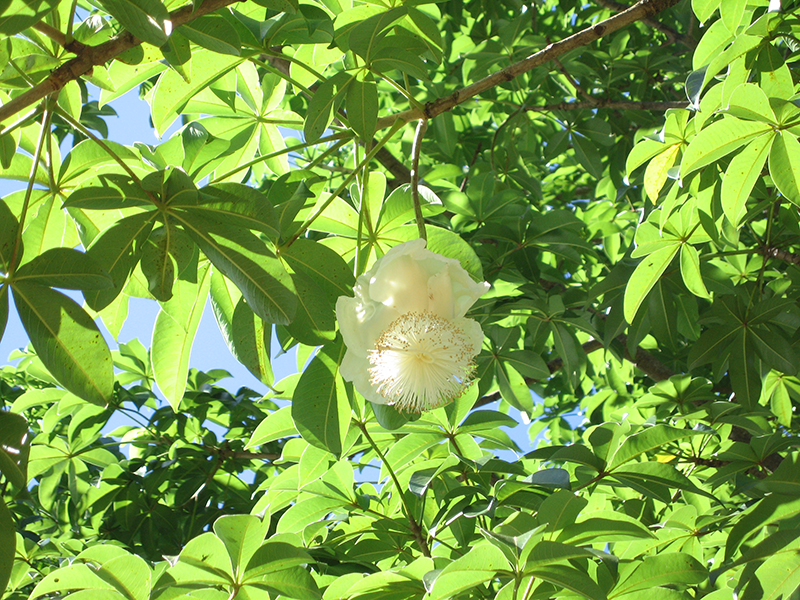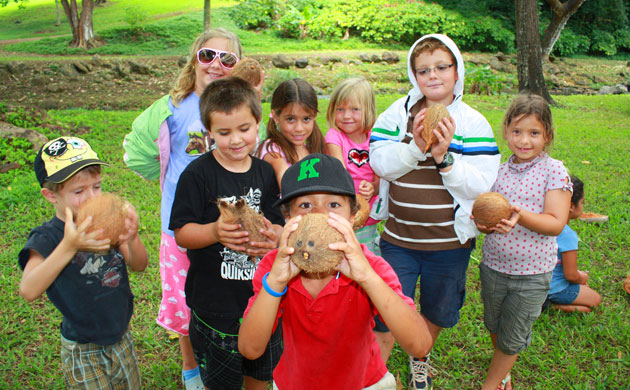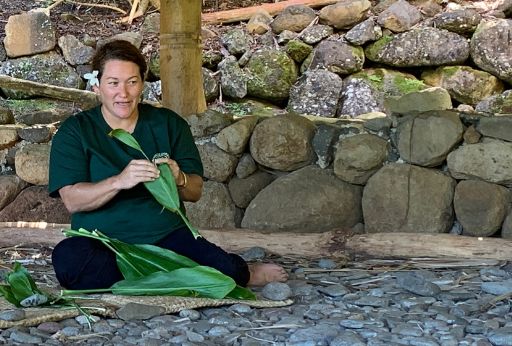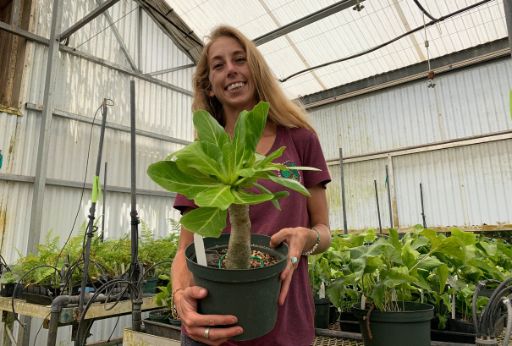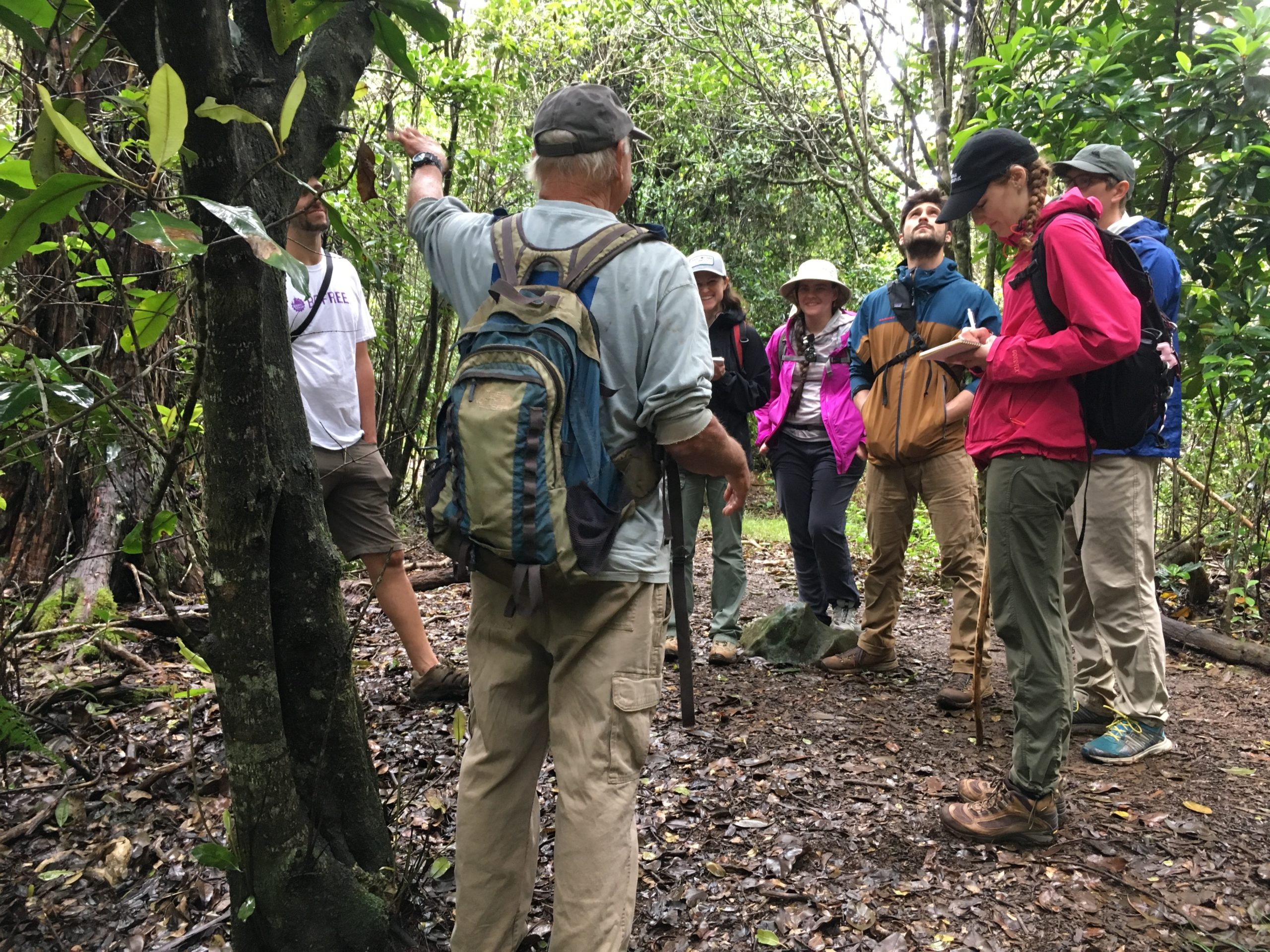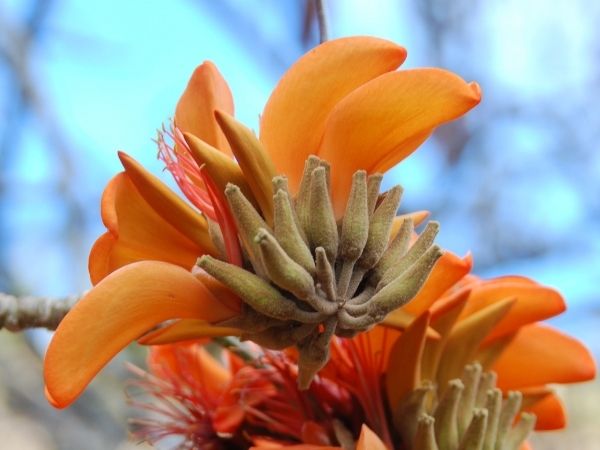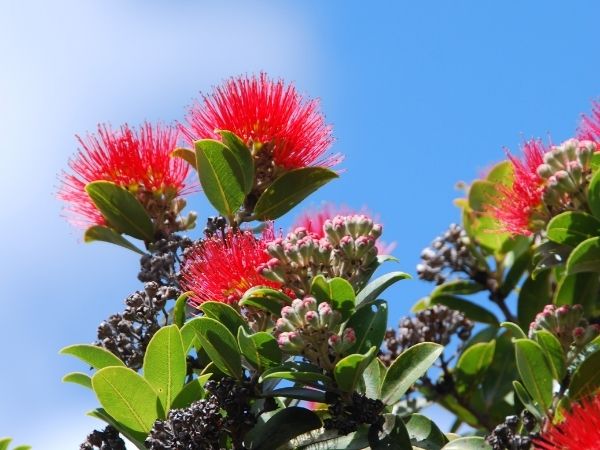Tropical Plant Database - Plant Details
Adansonia digitata
Conservation Status
- IUCN: Not Evaluated
- USFWS: None
Genus: Adansonia
Species: digitata
Species Author: L.
Vernacular: Baobab, Monkey Bread, Judas's bag, Bottle tree, Dead-rat tree
The main stem of larger Baobab Trees may reach enormous proportions of up to 28 m in girth, although baobab trees seldom exceed a height of 25 m. The massive, usually squat cylindrical trunk gives rise to thick tapering branches resembling a root-system, which is why it has often been referred to as the upside-down tree looking like it has been picked out of the ground and stuffed back in upside-down. The stem is covered with a bark layer, which may be 50-100 mm thick. The bark is greyish brown and normally smooth but can often be variously folded and seamed from years of growth. The baobab is leafless for nine months of the year. The leaves are hand-sized and divided into 5-7 finger-like leaflets. Being deciduous, the leaves are dropped during the winter months and appear again in late spring or early summer. The large, pendulous flowers (up to 200 mm in diameter) are white and sweetly scented. They emerge in the late afternoon from large round buds on long drooping stalks from October to December. The flowers fall within 24 hours, turning brown and smelling quite unpleasant. The fruit is a large, egg-shaped capsule, covered with a yellowish brown hairs. The fruit consists of a hard, woody outer shell with a dry, powdery substance inside that covers the hard, black, kidney-shaped seeds. This tree is slow growing, mainly due to the low rainfall it receives. (Coates Palgrave, K. 1985. Everyone's guide to trees of South Africa.) (Esterhuyse, N., Von Breitenbach, J. and Sohnge, H. 2001. Remarkable trees of South Africa.) (Germishuizen,G. and Meyer, N.L. 2003. Plants of southern Africa: an annotated checklist.) (Palmer, E. and Pitman, N. 1972. Trees of southern Africa.) (Venter, F. and Venter, J. 1985. Making the most of indigenous trees.)
The drink made from the white powdery substance soaked in water is also used to treat fevers and other complaints.
Large baobab trees with hollow stems have been used by people for centuries for various purposes including houses, prisons, pubs, storage barns, and even as bus stops! A big tree in the old Transvaal region is recorded as once being used as a dairy. Rainwater often collects in the clefts of the large branches, and travelers and local people often use this valuable source of water. It has been recorded that in some cases the centre of the tree is purposely hollowed out to serve as a reservoir for water during the rainy season. One such reservoir was recorded as holding 4546 litres of water. A hole is drilled in the trunk and a plug inserted so that water can be easily retrieved by removing the plug. The roots of the baobab can also be tapped for water. The bark on the lower part of the trunk often bears scars caused by local people who harvest and pound it to retrieve the strong fibre. The fibrous bark is used to make various useful items such as mats and ropes, fishing nets, fishing lines, sacks as well as clothing. Although the bark is often heavily stripped by people and elephants, these trees do not suffer as a normal tree would from ringbarking. Baobabs have the ability to simply continue growing and produce a new layer of bark. The wood of the baobab is soft, light yellow and spongy, and although it has been recorded as being used for making boxes, this does not seem to be a widely used practice. (Coates Palgrave, K. 1985. Everyone's guide to trees of South Africa.) (Esterhuyse, N., Von Breitenbach, J. and Sohnge, H. 2001. Remarkable trees of South Africa.) (Germishuizen,G. and Meyer, N.L. 2003. Plants of southern Africa: an annotated checklist.) (Palmer, E. and Pitman, N. 1972. Trees of southern Africa.) (Venter, F. and Venter, J. 1985. Making the most of indigenous trees.) (Information for this species compiled and recorded by Camelia Cirnaru, NTBG Consultant.)
The baobab tree is found in areas of South Africa, Botswana, Namibia, Mozambique and other tropical African countries where suitable habitat occurs. It is restricted to hot, dry woodland on stoney, well drained soils, in frost-free areas that receive low rainfall. In South Africa it is found only in the warm parts of the Limpopo Province. (Coates Palgrave, K. 1985. Everyone's guide to trees of South Africa.) (Esterhuyse, N., Von Breitenbach, J. and Sohnge, H. 2001. Remarkable trees of South Africa.) (Germishuizen,G. and Meyer, N.L. 2003. Plants of southern Africa: an annotated checklist.) (Palmer, E. and Pitman, N. 1972. Trees of southern Africa.) (Venter, F. and Venter, J. 1985. Making the most of indigenous trees.)
The off-white, powdery substance of the fruit is apparently rich in ascorbic acid. It is this white powdery substance which is soaked in water to provide a refreshing drink somewhat reminiscent of lemonade. The leaves are said to be rich in vitamin C, sugars, potassium tartrate, and calcium. They are cooked fresh as a vegetable or dried and crushed for later use by local people. The sprout of a young tree can be eaten like asparagus. The root of very young trees is also reputed to be edible. The seeds are also edible and can also be roasted for use as a coffee substitute. Caterpillars, which feed on the leaves, are collected and eaten by African people as an important source of protein. Wild animals eat the fallen leaves and fresh leaves are said to be good fodder for domestic animals. The fallen flowers are relished by wild animals and cattle alike. When the wood is chewed, it provides vital moisture to relieve thirst and humans as well as certain animals eat it in times of drought. (Coates Palgrave, K. 1985. Everyone's guide to trees of South Africa.) (Esterhuyse, N., Von Breitenbach, J. and Sohnge, H. 2001. Remarkable trees of South Africa.) (Germishuizen,G. and Meyer, N.L. 2003. Plants of southern Africa: an annotated checklist.) (Palmer, E. and Pitman, N. 1972. Trees of southern Africa.) (Venter, F. and Venter, J. 1985. Making the most of indigenous trees.)
Baobab trees flower for the first time at about 20 years. In mid-summer, dozens of luminous white blossoms - the size of saucers - open at sunset and their strong musky odour attracts fruit bats and hosts of insects. Large bats seek out the sweet nectar and collect and distribute pollen as they move from flower to flower. The flower is short lived and it drops to the ground within hours of being pollinated. The resultant seeds develop in a hairy pod which resembles a miniature rugby ball (inside of which is a white pulp from which a substance similar to "cream of tartar" is derived). Once they fall to the ground, the pods are fed upon by baboons, monkeys, antelope and elephants. The seeds are not generally eaten by animals and are discarded, thus effecting dispersal. African honey bees (Apis mellifera) often utilize hollows in the baobab to make their hives. One can often see a "ladder" of pegs hammered into the trunk which is used by seasonal honey harvesters to gain access to the hives. The sculptured branches, with their hollows, dents and bloated stems, provide shelter and home for a great variety of animals. Galagos (bushbaby), squirrels, rodents, lizards, snakes and tree frogs, as well as spiders, scorpions and insects may live out their entire life in a single tree. Holes in the trunk provide ideal nesting sites for birds such as rollers, hornbills, parrots, kestrels and spinetails. Larger cavities are frequently occupied by families of Barn Owls or Ground Hornbills. Eagles, vultures and storks frequently build their large stick nests on the outer branches, and the colonial nests of Red-billed Buffalo-weavers are more often found in Baobabs than any other tree. (Coates Palgrave, K. 1985. Everyone's guide to trees of South Africa.) (Esterhuyse, N., Von Breitenbach, J. and Sohnge, H. 2001. Remarkable trees of South Africa.) (Germishuizen,G. and Meyer, N.L. 2003. Plants of southern Africa: an annotated checklist.) (Palmer, E. and Pitman, N. 1972. Trees of southern Africa.) (Venter, F. and Venter, J. 1985. Making the most of indigenous trees.)
The name Adansonia was given to this tree to commemorate the French surgeon Michel Adanson (1727-1806). The species name "digitata" means "hand-like" and it is in reference to the shape of the leaves. There is a tale which tells of how God planted them upside-down. Many traditional Africans believe that the baobab actually grows upside-down. There are many legends and superstitions surrounding the baobab tree. For example, it is believed that an elephant frightened the maternal ancestor of the baobab. In some parts the baobab is worshipped as a symbol of fertility. It is a belief among certain people that spirits inhabit the flowers of the baobab and that any person who picks a flower will be eaten by a lion. It is also believed that water in which the seeds have been soaked will offer protection against attack by crocodile, while sucking or eating the seeds may attract crocodiles. It is also believed that a man who drinks an infusion of the bark will become strong. In some areas a baby boy should be bathed in such a bark infusion, as this will make him strong. However, he should not be bathed for too long or he may become obese. It is also important that this water does not touch his head for this could cause it to swell. When inhabitants move from one area to another they often take seeds of the baobab with them, which they plant at their new homestead. A legend of the Baobab describes what happens if you are never satified with what you already have: The baobab was among the first trees to appear on the land. Next came the slender, graceful palm tree. When the baobab saw the palm tree, it cried out that it wanted to be taller. Then the beautiful flame tree appeared with its red flower and the baobab was envious for flower blossoms. When the baobab saw the magnificent fig tree, it prayed for fruit as well. The gods became angry with the tree and pulled it up by its roots, then replanted it upside down to keep it quiet. (Coates Palgrave, K. 1985. Everyone's guide to trees of South Africa.) (Esterhuyse, N., Von Breitenbach, J. and Sohnge, H. 2001. Remarkable trees of South Africa.) (Germishuizen,G. and Meyer, N.L. 2003. Plants of southern Africa: an annotated checklist.) (Palmer, E. and Pitman, N. 1972. Trees of southern Africa.) (Venter, F. and Venter, J. 1985. Making the most of indigenous trees.)
Regarded as the largest succulent plant in the world, the baobab tree is steeped in a wealth of mystique, legend and superstition wherever it occurs in Africa. It is a tree that can provide, food, water, shelter and relief from sickness. The baobab was declared a protected tree under the Forest Act in South Africa in 1941. (Coates Palgrave, K. 1985. Everyone's guide to trees of South Africa.) (Esterhuyse, N., Von Breitenbach, J. and Sohnge, H. 2001. Remarkable trees of South Africa.) (Germishuizen,G. and Meyer, N.L. 2003. Plants of southern Africa: an annotated checklist.) (Palmer, E. and Pitman, N. 1972. Trees of southern Africa.) (Venter, F. and Venter, J. 1985. Making the most of indigenous trees.)
Baobabs may be the oldest life forms on the African continent, and many of the specimens still standing today have certainly been around since the birth of Christ, others perhaps longer. More recent work using carbon-dating techniques as well as the study of core samples showing growth rings, suggest that a tree with a diameter of 10 m may be as old as 2000 years. (Coates Palgrave, K. 1985. Everyone's guide to trees of South Africa.) (Esterhuyse, N., Von Breitenbach, J. and Sohnge, H. 2001. Remarkable trees of South Africa.) (Germishuizen,G. and Meyer, N.L. 2003. Plants of southern Africa: an annotated checklist.) (Palmer, E. and Pitman, N. 1972. Trees of southern Africa.) (Venter, F. and Venter, J. 1985. Making the most of indigenous trees.)
- 042846 - collected by Tim Flynn in 2004
- 042847 - collected by Tim Flynn in 2004
- 065546 - collected by Tim Flynn in 2012
- 066916 - collected by Tim Flynn in 2012
- S065788 - collected by Tim Flynn in 2012
- 085359 - collected by David H. Lorence in 2017
- 093336 - collected by David H. Lorence in 2017
- Unassigned - collected by Susan Fawcett in 2024
- 095510 - collected by Tim Flynn in 2025
- 095509 - collected by Tim Flynn in 2025
We currently have 10 herbarium specimens for Adansonia digitata in our collection. Click on any specimen below to view the herbarium sheet data.
.svg)






